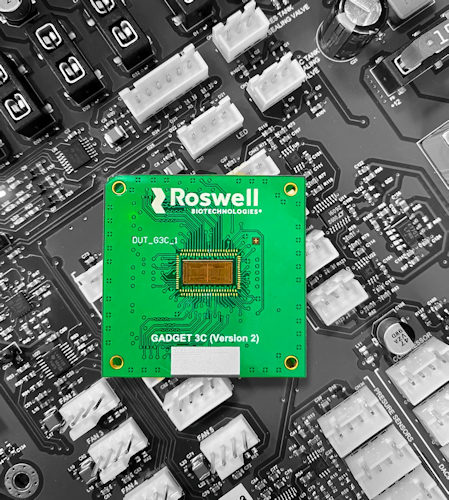January 26, 2022 -- Roswell Biotechnologies and leading academic scientists have developed the first molecular electronics chip, realizing a 50-year-old goal of integrating single molecules into circuits to achieve the ultimate scaling limits of Moore's Law.
The chip uses single molecules as universal sensor elements in a circuit to create a programmable biosensor with real-time, single-molecule sensitivity and unlimited scalability in sensor pixel density. The innovation, which was published in Proceedings of the National Academy of Sciences (PNAS), will power advances in diverse fields that are fundamentally based on observing molecular interactions, including drug discovery, diagnostics, DNA sequencing, and proteomics, according to the authors.

The molecular electronics platform consists of a programmable semiconductor chip with scalable sensor array architecture. Each array element consists of an electrical current meter that monitors the current flowing through a precision-engineered molecular wire assembled to span nanoelectrodes that couple it directly into the circuit. The sensor is programmed by attaching the desired probe molecule to the molecular wire via a central engineered conjugation site. The observed current provides a direct real-time electronic readout of molecular interactions of the probe.
The picoamp-scale current-versus-time measurements are read from the sensor array in digital form at a rate of 1,000 fps to capture molecular interactions data with high resolution, precision, and throughput.
The new molecular electronics platform detects multiomic molecular interactions at the single-molecule scale in real time. The PNAS paper presents a wide array of probe molecules, including DNA, aptamers, antibodies, and antigens, as well as the activity of enzymes relevant to diagnostics and sequencing, including a CRISPR Cas enzyme binding its target DNA. The paper illustrates a wide range of applications for such probes, including the potential for rapid COVID testing, drug discovery, and proteomics.
The article also presents a molecular electronics sensor capable of reading a DNA sequence. With this sensor, a DNA polymerase is integrated into the circuit, and the result is direct electrical observation of the action of this enzyme as it copies a piece of DNA, letter by letter.
Unlike other sequencing technologies that rely on indirect measures of polymerase activity, this approach achieves direct, real-time observation of a DNA polymerase enzyme incorporating nucleotides. The paper illustrates how these activity signals can be analyzed with machine-learning algorithms to allow reading of the sequence.
Copyright © 2022 scienceboard.net






